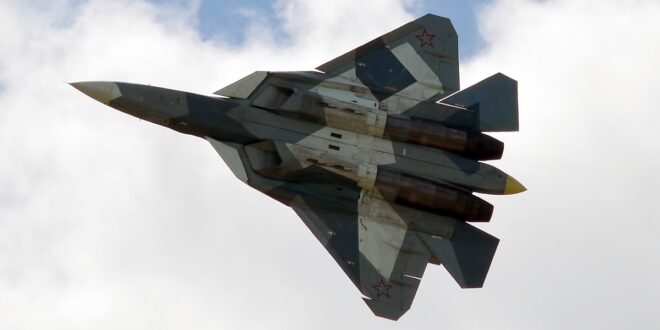Turkey is still blackmailing the U.S. (and NATO allies) that it may opt for a Russian fighter jet, the Su-57, for instance, in case it feels threatened by the lack of a new generation fighter aircraft. This is bluffing.
Turkish Air Force generals know too well that switching from NATO-standard aircraft to Russian ones after 70 years is not like changing your American car in favor of a Japanese one. Building a new operational structure, modifying air bases, new repair, service and maintenance systems will be too costly, time consuming and technologically difficult.
Erdoğan’s top officials are undermining themselves when they try to convince the public that Turkey’s local defense industry is making miracles in fighter jet technology.
In the meantime, fearing further U.S. sanctions, Turkey has suspended plans to activate the S-400 surface-to-air missile system…. This means Ankara paid a good $2.5 billion to Moscow for a system that it probably will never activate.
“This is a sale. We received our money. The Turks can ride the missiles to go to the beach or to carry potatoes with them. It’s not our concern.” — Aleksey Yerhov, Russia’s ambassador to Ankara, mocking Turkey’s reluctance to activate the S-400 surface-to-air missile system, onedio.com, July 6, 2020.
One of the hottest issues in the 50-minute discussion between Turkish President Recep Tayyip Erdoğan and U.S. President Joe Biden during the NATO summit of June 14 was NATO member Turkey’s acquisition of the Russian-made S-400 long-range air defense system and subsequent U.S. sanctions, including expelling Turkey from the U.S.-led multinational consortium that builds the F-35 fifth-generation fighter jet. Unsurprisingly, the meeting ended without a solution. That is bad news for the Turkish Air Force (TuAF).
For more than a decade, Turkey’s military top brass planned future air power capabilities based on the assumption that they would be receiving at least 100 F-35s starting in the 2020s. The TuAF operates squadrons of fourth-generation U.S.-built F-16s and older F-4s in its operations against separatist Kurdish militants in Turkey’s southeast as well as in northern Iraq and Syria. Turkey first began acquiring the F-16s from the U.S. in late 1980s and has locally produced the iconic fighter jet under license, being one of the five countries to locally produce the aircraft. Today, TuAF has a total of 270 F-16C/D aircraft in its inventory, all of them Block 30/40/50 models. Most of those aircraft will have to be phased out within the next 10 to 15 years, depending on their upgrades. Whether Congress will allow the sale of fighter jet parts and servicing for upgrades is another question mark.
What are Turkey’s options to minimize the inevitable decay in TuAF’s deterrence? Not too many. Turkey is still blackmailing the U.S. (and NATO allies) that it may opt for a Russian fighter jet, the Su-57, for instance, in case it feels threatened by the lack of a new generation fighter aircraft. This is bluffing. TuAF generals know too well that switching from NATO-standard aircraft to Russian ones after 70 years is not like changing your American car in favor of a Japanese one. Building a new operational structure, modifying air bases, new repair, service and maintenance systems will be too costly, time consuming and technologically difficult.
In theory, Turkey is proud of its own indigenous fighter jet program, the TF-X. Tusaş Turkish Aerospace Industries (TAI) has for years been running the TF-X program. Turkey’s defense and aerospace authorities have been announcing “breaking news” almost daily to update the public on the TF-X. Most recently, TAI announced that it started to build Europe’s second biggest supersonic wind tunnel for future tests of the TF-X. The company said it signed a deal with a Turkish university for the Turkish fighter jet’s software system. TAI has also unveiled the TF-X’s mock-up.
These are fairy tales Turks love to hear. The government-sponsored narrative about the Turkish fighter jet in the making aims is for domestic consumption only. Few Turks know that their aerospace engineering is at best decades away from building a new generation aircraft. TAI first aimed to fly the TF-X in 2023, the centennial of the Turkish Republic. It is now talking about 2025-2026 to take a prototype aircraft from the hangar. That deadline is not realistic either.
In reality, the TF-X is still at pre-conceptual design phase. In other words, it has not been designed yet — because you cannot design a fighter jet before choosing the engine that will power it. Turkey does not have aircraft engine technology but claims it is developing it. That claim, too, is for domestic consumption.
Erdoğan’s top officials are undermining themselves when they try to convince the public that Turkey’s local defense industry is making miracles in fighter jet technology. In a recent television debate, Mesut Caşin, one of Erdoğan’s chief advisors, took out what looked like a tiny model aircraft from his pocket and showed it to cameras, claiming “this will be Turkey’s national, indigenous fighter jet.”
In the meantime, fearing further U.S. sanctions, Turkey has suspended plans to activate the S-400 surface-to-air missile system. Although the official target to activate the system was April 2020, the Turkish military is keeping the S-400 “packed and inactivated.” This means Ankara paid a good $2.5 billion to Moscow for a system that it probably will never activate.
Russia’s ambassador to Ankara, Aleksey Yerhov, mocked Turkey’s reluctance to activate the Russian system for which it paid $2.5 billion when he said, “This is a sale. We received our money. The Turks can ride the missiles to go to the beach or to carry potatoes with them. It’s not our concern.” That was deeply embarrassing for Turkey.
But the show goes on. Ismail Demir, Erdoğan’s top defense procurement official, said on June 21, “The issue of the defense industry is a highly significant issue in diplomacy.” He was right. Turkey’s acquisition of the $2.5 billion Russian air defense architecture, its inability even to activate the system, and the consequences of that acquisition are textbook examples of how the defense industry can be mishandled in diplomacy.
 Eurasia Press & News
Eurasia Press & News


